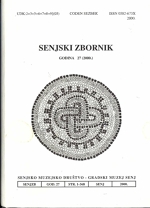SREDNJOVJEKOVNA SAKRALNA ARHITEKTURA U BRINJU I OKOLICI
THE MIDDLE-AGED SACRAL ARCHITECTURE AT BRINJE AND ITS SURROUNDDINGS
Author(s): Zorislav HorvatSubject(s): Architecture, Middle Ages, Theology and Religion
Published by: Senjsko muzejsko društvo i Gradski muzej Senj
Keywords: the middle-aged sacral architecture; Brinje and its surroundings; the fortress Brinje;
Summary/Abstract: A great number of sacral middle-aged buildings, various types of their construction and largeness provide evidence of an intensive development of Brinje during middle-ages. The Turkish aggression on the Croatia of that time made that a fairly great number of objects were attributed to an anonymous designation "crkvina" (which means a place where once stayed a church) while in some other places not even that one. The development of sacral architecture seems should be connected to a favourable location of Brinje on the important road going from the north to the south and also to the vicinity of Senj, and the Adriatic Sea. In fact, the key role had the noble family of princes from Krk, later the Frankopans. The oldest sacral building should perhaps be regarded the Chapel of St. Apollonius, located in a characteristic place, i.e. on the Illyrian fortification and place of the roman "tegula" finds. But, it will yet be the unknown until the archeological excavations have taken place. The romanism can't be found here before the Chapel of St. Fabian and Sebastian, which most probably was arisen later, meaning not during the blossoming of the romanism in the 12th -13th c. Perhaps, the romanism could be looked after on the place of trapezoidal sanctuary of a present-day sepulchral Chapel of St. Stephen the first martyr at Holjevac near Brinje. It would, however, mean that the elder settlement was not located on the same place as the later and Brinje of nowadays. In an obvious contrast are the sculpture of a she-wolf, carved with a very fine workmanship, and other equipment of St. Vid's as well as the coats of arms of the princes from Krk and the Frankopans. Meaning, those couldn't be pieces of work of the constructor of St. Vid's, but the sculpture must have been brought from somewhere, probably from some roman ruin. We wonder if it was not already the anticipating of the reneissance and taking over of the roman heritage. There are no traces of the sacral architecture in the 15th c. and specially not in the 16th c. In 1478 the king Matija Korvin took Brinje and Senj from the Frankopan princes and construction activities from that time on were oriented toward the fortification. Very soon the life out of the walls became not possible because of continuous Turkish assaults in those regions. In view of that, the construction of late-gothic churches and monasteries failed to take place there. In the course of the following two centuries the great number of buildings were reduced to ashes, unrestored, abandoned and only by the banishment of Turks in the late 17th c. the reconstructions could take place again. The monastery of the augustinians and its church were not preserved, but by the two fragments of the architectural plastics and by the largeness of sanctuary of the parish church of St. Mary could already be discerned architecture of Middle-European origin. The fortress Brinje with its chapel belong to the architecture of the highest category and it was obviously designed by the architect who was familiar with the activities of Peter Parler and the court shop of king Vaclav IV at Prag. Although the lack of precision and some simplifications, like deficiences of sculpture decorations with the exception of some rare and very simple details, the chapel and palace were by the beginning of the 15th c. the objects of the highest quality in Croatia of that time. So important site must have had some reflections on the Croatian architecture of that time and we can find it already with St.Vid's chapel at neighbouring Humac and perhaps also in the chapel of the fortification Komici of the Kurjakovići princes. The sanctuaries of both buildings were made "in peak" the same as in the collateral chapel at Brinje, which were in our country very exceptional examples of forming the ground-plan. The structure and the equipment of buildings at Brinje and its neighbourings responded to requirements and possibilities of the local population: from the modest rural objects to the rich architecture of the Frankopan princes from Krk. Design of modest rural objects responded to the so called "outskirts architecture" (Lj. Karaman), which from one side lives its own traditional life and from the other takes over the news in the construction, but applying them in the traditional way.
Journal: Senjski zbornik - prilozi za geografiju, etnologiju, gospodarstvo, povijest i kulturu
- Issue Year: 27/2000
- Issue No: 1
- Page Range: 97-146
- Page Count: 50
- Language: Croatian

